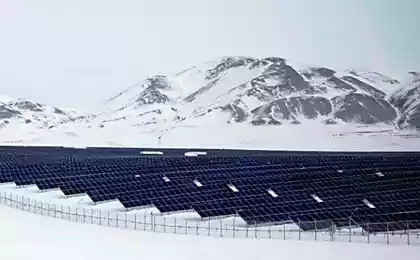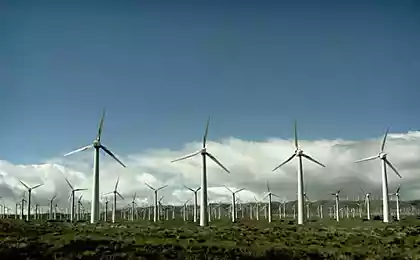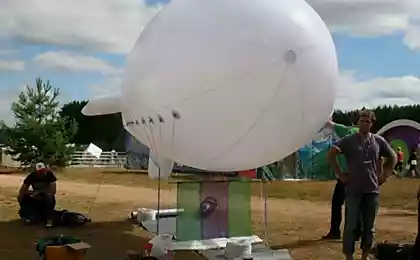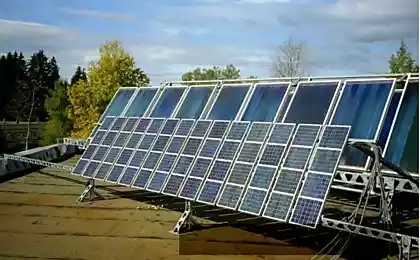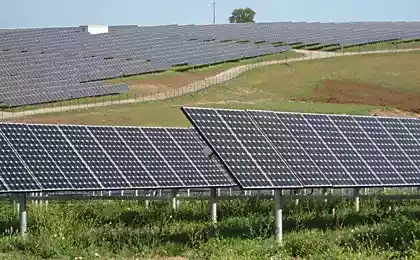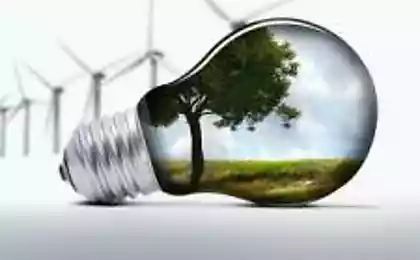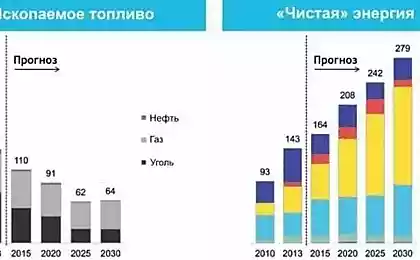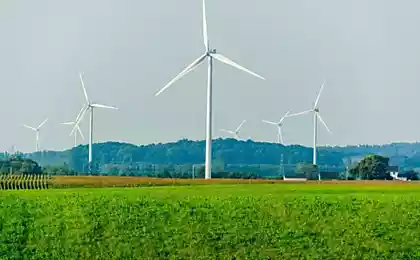755
Effective use of renewable energy sources
In Russia today there is an unprecedented rise in the cost of electricity consumed by the population. In addition to the annual "planned" increase its prices by 10 to 15 %, the payment for electricity consumption of all-house devices (Internet service providers, intercoms and cable networks, legal entities).
And according to the explanation posted online, the residents are obliged to pay for consumed electricity for those living in the house that were not paid by her for the past month. It may happen that if things go on like this, then all the electricity consumption of an apartment house will be obliged to pay one or two pensioners, and in the country two or three billionaires. As practice shows, the transition period in Russia everything is possible. For example, you can enter the charge for electricity, losing in the quarterly transformers, township, power lines, etc.
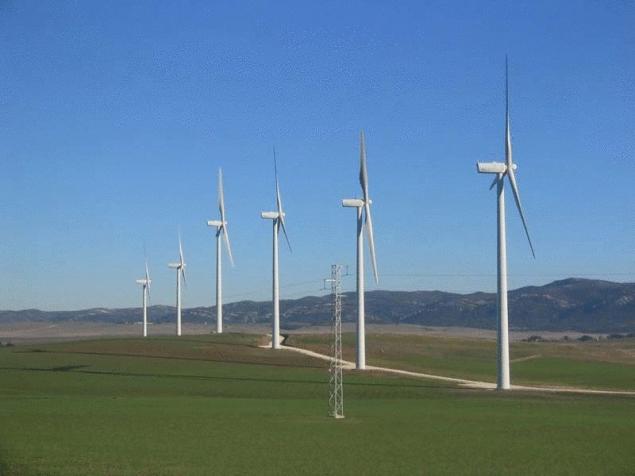
As at 31 March 2014 debts in the retail electricity market of Russia amounted to 189 billion rubles, an increase compared to AWP 2012/13 by almost 30%. The situation is complicated because of debts for heat by the beginning of April 2014 has also reached astronomical proportions — 140 billion roubles.
This raises the question of whether it is better to switch to electricity from renewable energy sources (RES), at least in the suburbs.
Currently, electric station (ES), energy of renewable energy sources in Russia, except hydroelectric power plants (HPP) and a small portion of geothermal power plants (GeoPP) are, if not unprofitable, with a very large payback period, which prevents their widespread use.
The question arises, why use free energy from the Sun, wind, heat of the Earth and small streams can not yet compete on a number of economic indicators, with the exception of environmental and social, with energy, often running on expensive fossil fuels.
Basically the economic efficiency of the systems and installations of energy renewable energy except for the cost of 1 kW of installed capacity depends on the ratio of installed capacity utilization (capacity factor), which in some areas of their operation unacceptably low. Buying, for example, expensive wind power plant (WPP), the user receives, as a rule, electricity 3 – 5 times or more less than it could produce at constant wind required values.
So according to S. P. Filippov utilization of installed capacity of power plants (table 1) is as follows.

Table 1 – utilization of installed capacity of power plants, small power industry of Russia (2007)
In 2010 – 2012 in the Crimea was built four solar photovoltaic station (FES) with a total capacity of 227.5 MW. The total power output on them in 2012 amounted to 303 million kWh which means that the Crimean FES capacity factor = 0,15.
And according to the open Internet sources, for a number of areas located along the southern border of Russia, capacity factor, can be as follows (table 2).

Table 2 – utilization of installed capacity of power plants using renewable energy sources in Russia (expert rating)
As can be seen from tables 1 and 2 when running on renewable energy very inefficiently used power, while at the thermoelectric power stations (TPS) capacity factor reaches large values. A higher capacity factor at the wind farm than in FES partly reflect the fact that the wind wheel is always oriented in the direction of the wind, unlike photovoltaic panels, morning and evening when the solar radiation is "sliding" along their working surfaces.
Much higher capacity factor achieved at coal and gas power plants, because of implemented internal and external energy relations presented in figure 1.

Figure 1 – schematic diagram of the major internal and external energy relations of plants running on coal.
Gyr – receipt of coal;
Ft.VP, Ft.NP– the heat flow high and low potential;
Ft – reset low-grade heat into the environment;
PV – electricity supply to the consumer
Coal-fired power plants using imported fossil fuels, bringing the cost of reducing harmful emissions, does not produce expensive electricity. This is due to the fact that the low cost of 1 kW of installed capacity of ES, the use of coal stocks from the warehouse will pick up the equipment for each technological conversion, working with rated load. Especially in periods of the greatest consumption of electric energy. Although the average capacity factor for power plants is 50 %. For nuclear power plants — 75 – 78 %.
The cost of 1 kW of installed capacity in turn depends on the efficiency of the main technological processes. As you know high efficiency at thermal power plants, is achieved by the extended (for temperature) steam thermal (thermodynamic) cycle, although it is somewhat lower in the summer than in winter, due to the lack of large amounts of cold to reduce the lower boundary of the steam cycle.
But this is not equally true of all the EU, working on organic fuel. So many towns in the North of the European part of Russia, Siberia and the Far East supplied with electricity from a diesel power plant (DPP) with a capacity of up to 1.5 MW. The number of hours of use of these DES is about 1000 hours per year (capacity factor = 0,11), with the duration of their work 5 – 8 hours per day (morning and evening). Therefore, they produce electricity one of the most expensive.
In the first approximation scheme 1 can be extended to ES, biomass and biogas. This is due to their higher capacity factor (table 2).
Now consider figure 2 the external and internal energy when hydroelectric power station.
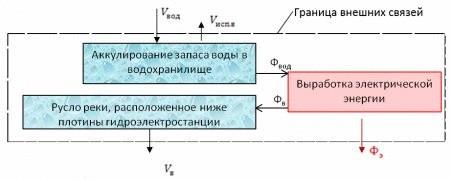
Figure 2 – schematic diagram of basic external and internal energy hydroelectric
Vвод – the flow of water in the reservoir hydroelectric power station;
Vисп.in the evaporation of water from the reservoir;
Fwod – water flow to the turbine;
PV – vent low-grade water in the riverbed; – the flow of water downstream;
PV – electricity supply to the consumer
From figure 2 it must follow that since high-pressure water flow supplied to the turbine without the cost of energy — naturally, the cost of electricity, hydropower, at close values of 1 kW of installed capacity for thermal power plants, should be much less than from coal plants. However, this is not always the case.
In the spring through the sites of existing HPPs is on average 60% of annual water flow. At the same time from 10 to 25 % of the annual water flow of hydroelectric reset idle due to the lack of regulating capacity of the reservoir. This primarily relates to low-pressure turbines in dams and rivers of the Central plains, with the result that during the year all the turbines at hydroelectric power plants operate at nominal power only in the spring. And the rest of the year, part of their works at reduced capacity or is idle. Therefore, hydropower can provide electricity supply to consumer demand (nominal production in summer, autumn and especially in winter).
When the area of the reservoir of Novosibirsk hydroelectric power station 1072 km2, annual power generation is 1,678 billion kWh Or 1 m2 1.56 kWh per year, with an average annual capacity factor of about 40 %. And the Sayano-Shushenskaya hydroelectric power station with an area of 621 km2 reservoir was developed in the year about 23.5 billion kWh of electricity. Or 1 m2 38 kWh per year, with an average annual capacity factor of about 42 %. Of course to a large extent the low capacity factor associated with the loss of large amounts of water from evaporation.
The cost of electricity generated is hydroelectric also not affected by high energy density flow of the working fluid is water.
The above examples of electricity generation show that the payback period of the projects, its cost is primarily affected by capacity factor, which depends mainly on the supply of primary energy (coal, water), their energy capacities, the possibility of its (primary energy) uniform at the time of receipt to convert into electricity.
In the task of providing small consumers with uninterrupted power supply are often used schematics, with the accumulation of developed wind farm, photovoltaic or diesel generator power.
Figure 3 shows the external and internal energy when the wind farms.
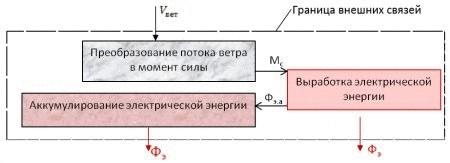
Figure 3 – schematic diagram of basic external and internal energy of a wind power station.
Vвет – flow of air to the turbine;
MS – torque transmission to the generator;
Fe.a – the flow of electricity for charging the battery;
PV – electricity supply to the consumer
Approximately well will look, given the inherent differences technological updating, a diagram of the main internal and external energy relations of FES and diagram of gasoline generator and batteries.
From figure 3 it can be seen that the vacation to the consumer of electricity can run smoothly and with no wind to total discharge.
But, such decisions clearly lead to a sharp increase in the cost of 1 kW∙h of electricity. So, for uninterrupted power supply to consumers 1 kWh of electricity for 100 hours (4 days) when the court of a weak wind or no Sun required 100 kWh of electricity, which can be obtained from 138 of the battery (normal car battery with a capacity of 60 Ah voltage of 12 V after full charge is able to give 0.72 per kWh of electricity). And that, as a rule, can not afford the vast majority of Russia's population.
Of course, to increase the stability of the output of electricity to the consumer is relevant the use of other, different drives, designed to ensure the supply of power not below the minimum; the grant of power in peak periods; meet their needs; the suppression of the transient peaks generated by the wind farm power output; the distribution of power on a predictable schedule, as provided for "wind farms". To solve these problems for "wind farms" in addition to hydraulic drives, the use of compressed air energy storage, regenerative batteries, hydrogen systems, and for the medium VES — flywheels, induction of SP-drives and sverkajuschii.
However, for small power systems under stochastic revenues of renewable energy the use of such devices cumbersome, because the smaller the capacity of the battery storage, the more expensive its 1 kW of installed capacity, with a sharp drop in its capacity factor, especially in the presence of one or two consumers.
Small guaranteed supply of electricity can be solved with the help of Geothermal, however, in most parts of the Earth where there is volcanic activity too quickly are depleted of deep heat resources. Because of this large capital costs for the construction of GeoPP not pay off.
On the assumption that the efficient use of renewable energy depends on the capacity factor, or to be more precise, in the end, from drive-battery, primary energy proposed to determine for each area the cost of 1 kW of installed capacity taking into account capacity factor (table 3).

Table 3 – Cost of 1 kW of installed capacity of power plants using renewable sources of energy in Russia taking into account the potential of renewable source of energy (utilization of installed capacity), in us dollars
* number and capacity of batteries depends on the capacity factor ES of a particular type for a particular location.
** in several districts of Omsk region for wind farm with capacity factor =0,1 actual cost of 1 kW of installed capacity, according to the proposed technique of estimation of efficiency of use of ES would amount to $ 25,000.The proposed transition to the assessment of the actual cost of 1 kW of installed capacity based on the capacity factor will contribute to a more objective assessment of the possible use of ES from renewable energy sources for each specific area and even places.
Based on the results obtained (table 3) promising heliobacteria based on solar salt ponds, is shown in figure 4.
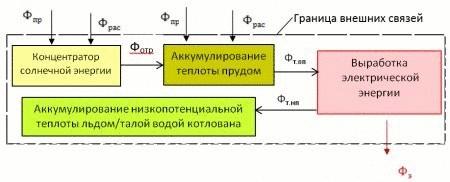
Figure 4 – schematic diagram of the major internal and external energy relations gelioelektrostantsii based on solar salt pond.
FPR, Fur, FRAS – luminous flux direct, reflected and scattered solar radiation;
Ft.VP, Ft.NP– the heat flow high and low potential;
PV – holidays elektroenergiyu contrast to conventional solar power plant with heliostats, where the concentration of energy is achieved by optical methods, solar salt pond provides a hydrodynamic concentration of solar energy. The average density of the inflow of solar heat in the exhaust of the heated brine is 75 W/m2 flux density used enthalpy (the product of the density of the brine — 1500 kg/m3, its speed in the pipe is 1 m/s, the heat capacity of 2.3 kJ/kg∙ ° C and temperature difference 10 ° C) is 3.5∙107 W/m2. This shows that the hydrodynamic concentration increases the power density by more than five orders of magnitude, i.e. in hundreds of thousands of times.
Ability to perform work is characterized by a flow of energy, flow of exergy and therefore it is necessary to pay attention to the concentration exergy of the solar pond.
The flux density of the exergy of solar radiation is much lower energy density (about half), so that it is possible to estimate the average value of δ o = 100 W/m2. Is supplied to the pond exergy. The exhaust is the exergy of the hot brine is measured only by its temperature, i.e. thermal, but not chemical exergy. When the temperature of the hot brine 100 ° C and the cold source temperature 10 ° C have δэ = 3,5∙107∙(100 — 10)/(100 + 273) = 0,93∙107 W/m2. The ratio of the fluxes of input and exhaust exergy: λ = δэ/δ o = 107/102 = 105.
In other words, when the withdrawal of hot brine, we obtain the hydrodynamic focus flow exergy of a hundred thousand times. The flux density of the exergy in the hot brine is much higher than when transferring energy from the hot gases in the caudal parts of the boiler unit, and higher than in ocean thermal power plants. Therefore, solar pond and appears to be an effective collector of renewable energy due to the high concentration of exergy and he is paid so much attention to E. I. Yantovskii.
In cloudy weather when cooling at 10 ° C the bottom layer of the pond with an area of 78.5 m2 (diameter 10 m) is approximately 3600 MJ of heat. If this heat with an efficiency of 10 %, converted into electrical energy, it is possible to receive 100 kWh of electricity. And this is equivalent to the discharge 138 of expensive batteries, as mentioned previously.
To a large extent on the effectiveness of this type of plant affects the tracking the hub position of the Sun and use the cold ice of the pit. The use of cold of the pit allows to reduce the lower boundary of the steam cycle, leading to a significant increase in its efficiency.
Previously it was thought that the climatic conditions in the middle zone of Russia is unique due to the abnormally low temperatures, only Exploitation. Since this reduces the temperature of condensation, especially in winter, which can produce an increase (by 20 – 40 %) in electricity production compared to Geothermal, which are located in areas with hot and temperate climate. However, this advantage of our climate, in terms of increasing the efficiency of electricity generation are equally applicable to and ES based on solar salt pond and trench with ice.
Reducing the installed cost of 1 kW of ES based on solar salt pond can be achieved if the cold source for the thermodynamic cycle used instead of the cold ice of the pit cold small streams.
If you compare the price of 1 kW of installed capacity, conventional VES have the advantage compared to heliobacteria based on solar salt pond, but if their efficiency is to compare the subject to the batteries included in the WPP, providing an uninterrupted supply of electricity, the result is different.
Of course, at an efficiency of conversion of thermal energy of solar salt pond electric power in the range of 10 – 12 %, when the density of the solar radiation not exceeding, in the longer period of time of 1 kW/m2 due to electricity generation payback can only be achieved in decentralized areas. However, if part of the warmth of the pond to be used for hot water and part cold ice pit for conditioning, the payback can be achieved in the areas of centralized power supply. After heating the water in the pond 8 – 10 times cheaper than from electricity. Also air conditioning (air cooling) due to natural cold (ice pit) in 8 – 10 times cheaper than electrically driven air conditioners.
At the GES and ES based on solar salt pond and trench with ice/melt water has an additional, peculiar only to them the benefits.
At the power station the warmth of the water flow downstream, and heliobacteria warmth melt water of the pit and solar salt pond can be effectively used in winter for heating by heat pump units (HPU).
Mean annual runoff of the Yenisei river in the alignment of the Sayano-Shushenskaya HPP is 46,7 km3/year. The average annual water temperature downstream is equal to approximately 7 OS. The Yenisei is a powerful source of low-grade heat energy, suitable for use in TNU. Cooling of the river water in heat-exchange devices only 1 OS that will allow you to 1,9614∙1014 kJ/yr of thermal energy, i.e. heat power of the Yenisei river will be 6220 MW and will be close to the installed capacity of the Sayano-Shushenskaya hydroelectric power plant is 6400 MW.
Benefits of using winter TNU low-grade heat sources of different volumes: a large volume (of the pit with freezing water) with the temperature below 0 ° C and small (the cooling of brine in solar salt pond) with temperatures above 0 ° C detailed discussed in my work "Solar energy, its derivatives and the methods of their use (Introduction to energy, renewable energy)".
INSIGHTS
The fundamental scheme of the major internal and external energy relations of the different ES have shown that their effectiveness depends on many factors.
The analysis showed that to calculate the parameters of effective work of ES from renewable energy sources in conditions of stochastic disturbances, to ensure uninterrupted power supply is required during the design and equipment for energy accumulation, the price components of the storage-batteries.
Actual cost of 1 kW of installed capacity of installations and energy systems renewable energy sources for uninterrupted power supply should be determined taking into account the coefficient of utilization of installed capacity for a particular area. And the quantity and price of primary batteries or generated power should be based on inherent in this area of the impermanence of renewable energy.
For example, the scheme of the major internal and external energy relations gelioelektrostantsii based on solar salt pond and trench with ice/melt water, shown to be one of the most effective mechanisms to improve the efficiency of ES is not only the accumulation of primary energy (Sun) for steam cycle, but also the use for energy of ice in the pit (cold small streams).
From an economic point of view, the primary factor in the efficient use of renewable energy is the accumulation of the primary energy input to the generation system, that excess is provided for HPP only in the spring, and for heliobacteria based on solar salt pond, depending on the insolation during the summer period.
Osadchiy G. B., engineer, author of more than 140 inventions of the USSR
Source: alternativenergy.ru
And according to the explanation posted online, the residents are obliged to pay for consumed electricity for those living in the house that were not paid by her for the past month. It may happen that if things go on like this, then all the electricity consumption of an apartment house will be obliged to pay one or two pensioners, and in the country two or three billionaires. As practice shows, the transition period in Russia everything is possible. For example, you can enter the charge for electricity, losing in the quarterly transformers, township, power lines, etc.

As at 31 March 2014 debts in the retail electricity market of Russia amounted to 189 billion rubles, an increase compared to AWP 2012/13 by almost 30%. The situation is complicated because of debts for heat by the beginning of April 2014 has also reached astronomical proportions — 140 billion roubles.
This raises the question of whether it is better to switch to electricity from renewable energy sources (RES), at least in the suburbs.
Currently, electric station (ES), energy of renewable energy sources in Russia, except hydroelectric power plants (HPP) and a small portion of geothermal power plants (GeoPP) are, if not unprofitable, with a very large payback period, which prevents their widespread use.
The question arises, why use free energy from the Sun, wind, heat of the Earth and small streams can not yet compete on a number of economic indicators, with the exception of environmental and social, with energy, often running on expensive fossil fuels.
Basically the economic efficiency of the systems and installations of energy renewable energy except for the cost of 1 kW of installed capacity depends on the ratio of installed capacity utilization (capacity factor), which in some areas of their operation unacceptably low. Buying, for example, expensive wind power plant (WPP), the user receives, as a rule, electricity 3 – 5 times or more less than it could produce at constant wind required values.
So according to S. P. Filippov utilization of installed capacity of power plants (table 1) is as follows.

Table 1 – utilization of installed capacity of power plants, small power industry of Russia (2007)
In 2010 – 2012 in the Crimea was built four solar photovoltaic station (FES) with a total capacity of 227.5 MW. The total power output on them in 2012 amounted to 303 million kWh which means that the Crimean FES capacity factor = 0,15.
And according to the open Internet sources, for a number of areas located along the southern border of Russia, capacity factor, can be as follows (table 2).

Table 2 – utilization of installed capacity of power plants using renewable energy sources in Russia (expert rating)
As can be seen from tables 1 and 2 when running on renewable energy very inefficiently used power, while at the thermoelectric power stations (TPS) capacity factor reaches large values. A higher capacity factor at the wind farm than in FES partly reflect the fact that the wind wheel is always oriented in the direction of the wind, unlike photovoltaic panels, morning and evening when the solar radiation is "sliding" along their working surfaces.
Much higher capacity factor achieved at coal and gas power plants, because of implemented internal and external energy relations presented in figure 1.

Figure 1 – schematic diagram of the major internal and external energy relations of plants running on coal.
Gyr – receipt of coal;
Ft.VP, Ft.NP– the heat flow high and low potential;
Ft – reset low-grade heat into the environment;
PV – electricity supply to the consumer
Coal-fired power plants using imported fossil fuels, bringing the cost of reducing harmful emissions, does not produce expensive electricity. This is due to the fact that the low cost of 1 kW of installed capacity of ES, the use of coal stocks from the warehouse will pick up the equipment for each technological conversion, working with rated load. Especially in periods of the greatest consumption of electric energy. Although the average capacity factor for power plants is 50 %. For nuclear power plants — 75 – 78 %.
The cost of 1 kW of installed capacity in turn depends on the efficiency of the main technological processes. As you know high efficiency at thermal power plants, is achieved by the extended (for temperature) steam thermal (thermodynamic) cycle, although it is somewhat lower in the summer than in winter, due to the lack of large amounts of cold to reduce the lower boundary of the steam cycle.
But this is not equally true of all the EU, working on organic fuel. So many towns in the North of the European part of Russia, Siberia and the Far East supplied with electricity from a diesel power plant (DPP) with a capacity of up to 1.5 MW. The number of hours of use of these DES is about 1000 hours per year (capacity factor = 0,11), with the duration of their work 5 – 8 hours per day (morning and evening). Therefore, they produce electricity one of the most expensive.
In the first approximation scheme 1 can be extended to ES, biomass and biogas. This is due to their higher capacity factor (table 2).
Now consider figure 2 the external and internal energy when hydroelectric power station.

Figure 2 – schematic diagram of basic external and internal energy hydroelectric
Vвод – the flow of water in the reservoir hydroelectric power station;
Vисп.in the evaporation of water from the reservoir;
Fwod – water flow to the turbine;
PV – vent low-grade water in the riverbed; – the flow of water downstream;
PV – electricity supply to the consumer
From figure 2 it must follow that since high-pressure water flow supplied to the turbine without the cost of energy — naturally, the cost of electricity, hydropower, at close values of 1 kW of installed capacity for thermal power plants, should be much less than from coal plants. However, this is not always the case.
In the spring through the sites of existing HPPs is on average 60% of annual water flow. At the same time from 10 to 25 % of the annual water flow of hydroelectric reset idle due to the lack of regulating capacity of the reservoir. This primarily relates to low-pressure turbines in dams and rivers of the Central plains, with the result that during the year all the turbines at hydroelectric power plants operate at nominal power only in the spring. And the rest of the year, part of their works at reduced capacity or is idle. Therefore, hydropower can provide electricity supply to consumer demand (nominal production in summer, autumn and especially in winter).
When the area of the reservoir of Novosibirsk hydroelectric power station 1072 km2, annual power generation is 1,678 billion kWh Or 1 m2 1.56 kWh per year, with an average annual capacity factor of about 40 %. And the Sayano-Shushenskaya hydroelectric power station with an area of 621 km2 reservoir was developed in the year about 23.5 billion kWh of electricity. Or 1 m2 38 kWh per year, with an average annual capacity factor of about 42 %. Of course to a large extent the low capacity factor associated with the loss of large amounts of water from evaporation.
The cost of electricity generated is hydroelectric also not affected by high energy density flow of the working fluid is water.
The above examples of electricity generation show that the payback period of the projects, its cost is primarily affected by capacity factor, which depends mainly on the supply of primary energy (coal, water), their energy capacities, the possibility of its (primary energy) uniform at the time of receipt to convert into electricity.
In the task of providing small consumers with uninterrupted power supply are often used schematics, with the accumulation of developed wind farm, photovoltaic or diesel generator power.
Figure 3 shows the external and internal energy when the wind farms.

Figure 3 – schematic diagram of basic external and internal energy of a wind power station.
Vвет – flow of air to the turbine;
MS – torque transmission to the generator;
Fe.a – the flow of electricity for charging the battery;
PV – electricity supply to the consumer
Approximately well will look, given the inherent differences technological updating, a diagram of the main internal and external energy relations of FES and diagram of gasoline generator and batteries.
From figure 3 it can be seen that the vacation to the consumer of electricity can run smoothly and with no wind to total discharge.
But, such decisions clearly lead to a sharp increase in the cost of 1 kW∙h of electricity. So, for uninterrupted power supply to consumers 1 kWh of electricity for 100 hours (4 days) when the court of a weak wind or no Sun required 100 kWh of electricity, which can be obtained from 138 of the battery (normal car battery with a capacity of 60 Ah voltage of 12 V after full charge is able to give 0.72 per kWh of electricity). And that, as a rule, can not afford the vast majority of Russia's population.
Of course, to increase the stability of the output of electricity to the consumer is relevant the use of other, different drives, designed to ensure the supply of power not below the minimum; the grant of power in peak periods; meet their needs; the suppression of the transient peaks generated by the wind farm power output; the distribution of power on a predictable schedule, as provided for "wind farms". To solve these problems for "wind farms" in addition to hydraulic drives, the use of compressed air energy storage, regenerative batteries, hydrogen systems, and for the medium VES — flywheels, induction of SP-drives and sverkajuschii.
However, for small power systems under stochastic revenues of renewable energy the use of such devices cumbersome, because the smaller the capacity of the battery storage, the more expensive its 1 kW of installed capacity, with a sharp drop in its capacity factor, especially in the presence of one or two consumers.
Small guaranteed supply of electricity can be solved with the help of Geothermal, however, in most parts of the Earth where there is volcanic activity too quickly are depleted of deep heat resources. Because of this large capital costs for the construction of GeoPP not pay off.
On the assumption that the efficient use of renewable energy depends on the capacity factor, or to be more precise, in the end, from drive-battery, primary energy proposed to determine for each area the cost of 1 kW of installed capacity taking into account capacity factor (table 3).

Table 3 – Cost of 1 kW of installed capacity of power plants using renewable sources of energy in Russia taking into account the potential of renewable source of energy (utilization of installed capacity), in us dollars
* number and capacity of batteries depends on the capacity factor ES of a particular type for a particular location.
** in several districts of Omsk region for wind farm with capacity factor =0,1 actual cost of 1 kW of installed capacity, according to the proposed technique of estimation of efficiency of use of ES would amount to $ 25,000.The proposed transition to the assessment of the actual cost of 1 kW of installed capacity based on the capacity factor will contribute to a more objective assessment of the possible use of ES from renewable energy sources for each specific area and even places.
Based on the results obtained (table 3) promising heliobacteria based on solar salt ponds, is shown in figure 4.

Figure 4 – schematic diagram of the major internal and external energy relations gelioelektrostantsii based on solar salt pond.
FPR, Fur, FRAS – luminous flux direct, reflected and scattered solar radiation;
Ft.VP, Ft.NP– the heat flow high and low potential;
PV – holidays elektroenergiyu contrast to conventional solar power plant with heliostats, where the concentration of energy is achieved by optical methods, solar salt pond provides a hydrodynamic concentration of solar energy. The average density of the inflow of solar heat in the exhaust of the heated brine is 75 W/m2 flux density used enthalpy (the product of the density of the brine — 1500 kg/m3, its speed in the pipe is 1 m/s, the heat capacity of 2.3 kJ/kg∙ ° C and temperature difference 10 ° C) is 3.5∙107 W/m2. This shows that the hydrodynamic concentration increases the power density by more than five orders of magnitude, i.e. in hundreds of thousands of times.
Ability to perform work is characterized by a flow of energy, flow of exergy and therefore it is necessary to pay attention to the concentration exergy of the solar pond.
The flux density of the exergy of solar radiation is much lower energy density (about half), so that it is possible to estimate the average value of δ o = 100 W/m2. Is supplied to the pond exergy. The exhaust is the exergy of the hot brine is measured only by its temperature, i.e. thermal, but not chemical exergy. When the temperature of the hot brine 100 ° C and the cold source temperature 10 ° C have δэ = 3,5∙107∙(100 — 10)/(100 + 273) = 0,93∙107 W/m2. The ratio of the fluxes of input and exhaust exergy: λ = δэ/δ o = 107/102 = 105.
In other words, when the withdrawal of hot brine, we obtain the hydrodynamic focus flow exergy of a hundred thousand times. The flux density of the exergy in the hot brine is much higher than when transferring energy from the hot gases in the caudal parts of the boiler unit, and higher than in ocean thermal power plants. Therefore, solar pond and appears to be an effective collector of renewable energy due to the high concentration of exergy and he is paid so much attention to E. I. Yantovskii.
In cloudy weather when cooling at 10 ° C the bottom layer of the pond with an area of 78.5 m2 (diameter 10 m) is approximately 3600 MJ of heat. If this heat with an efficiency of 10 %, converted into electrical energy, it is possible to receive 100 kWh of electricity. And this is equivalent to the discharge 138 of expensive batteries, as mentioned previously.
To a large extent on the effectiveness of this type of plant affects the tracking the hub position of the Sun and use the cold ice of the pit. The use of cold of the pit allows to reduce the lower boundary of the steam cycle, leading to a significant increase in its efficiency.
Previously it was thought that the climatic conditions in the middle zone of Russia is unique due to the abnormally low temperatures, only Exploitation. Since this reduces the temperature of condensation, especially in winter, which can produce an increase (by 20 – 40 %) in electricity production compared to Geothermal, which are located in areas with hot and temperate climate. However, this advantage of our climate, in terms of increasing the efficiency of electricity generation are equally applicable to and ES based on solar salt pond and trench with ice.
Reducing the installed cost of 1 kW of ES based on solar salt pond can be achieved if the cold source for the thermodynamic cycle used instead of the cold ice of the pit cold small streams.
If you compare the price of 1 kW of installed capacity, conventional VES have the advantage compared to heliobacteria based on solar salt pond, but if their efficiency is to compare the subject to the batteries included in the WPP, providing an uninterrupted supply of electricity, the result is different.
Of course, at an efficiency of conversion of thermal energy of solar salt pond electric power in the range of 10 – 12 %, when the density of the solar radiation not exceeding, in the longer period of time of 1 kW/m2 due to electricity generation payback can only be achieved in decentralized areas. However, if part of the warmth of the pond to be used for hot water and part cold ice pit for conditioning, the payback can be achieved in the areas of centralized power supply. After heating the water in the pond 8 – 10 times cheaper than from electricity. Also air conditioning (air cooling) due to natural cold (ice pit) in 8 – 10 times cheaper than electrically driven air conditioners.
At the GES and ES based on solar salt pond and trench with ice/melt water has an additional, peculiar only to them the benefits.
At the power station the warmth of the water flow downstream, and heliobacteria warmth melt water of the pit and solar salt pond can be effectively used in winter for heating by heat pump units (HPU).
Mean annual runoff of the Yenisei river in the alignment of the Sayano-Shushenskaya HPP is 46,7 km3/year. The average annual water temperature downstream is equal to approximately 7 OS. The Yenisei is a powerful source of low-grade heat energy, suitable for use in TNU. Cooling of the river water in heat-exchange devices only 1 OS that will allow you to 1,9614∙1014 kJ/yr of thermal energy, i.e. heat power of the Yenisei river will be 6220 MW and will be close to the installed capacity of the Sayano-Shushenskaya hydroelectric power plant is 6400 MW.
Benefits of using winter TNU low-grade heat sources of different volumes: a large volume (of the pit with freezing water) with the temperature below 0 ° C and small (the cooling of brine in solar salt pond) with temperatures above 0 ° C detailed discussed in my work "Solar energy, its derivatives and the methods of their use (Introduction to energy, renewable energy)".
INSIGHTS
The fundamental scheme of the major internal and external energy relations of the different ES have shown that their effectiveness depends on many factors.
The analysis showed that to calculate the parameters of effective work of ES from renewable energy sources in conditions of stochastic disturbances, to ensure uninterrupted power supply is required during the design and equipment for energy accumulation, the price components of the storage-batteries.
Actual cost of 1 kW of installed capacity of installations and energy systems renewable energy sources for uninterrupted power supply should be determined taking into account the coefficient of utilization of installed capacity for a particular area. And the quantity and price of primary batteries or generated power should be based on inherent in this area of the impermanence of renewable energy.
For example, the scheme of the major internal and external energy relations gelioelektrostantsii based on solar salt pond and trench with ice/melt water, shown to be one of the most effective mechanisms to improve the efficiency of ES is not only the accumulation of primary energy (Sun) for steam cycle, but also the use for energy of ice in the pit (cold small streams).
From an economic point of view, the primary factor in the efficient use of renewable energy is the accumulation of the primary energy input to the generation system, that excess is provided for HPP only in the spring, and for heliobacteria based on solar salt pond, depending on the insolation during the summer period.
Osadchiy G. B., engineer, author of more than 140 inventions of the USSR
Source: alternativenergy.ru



